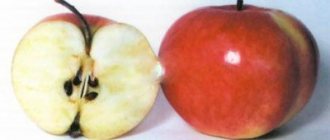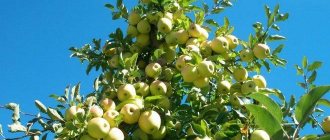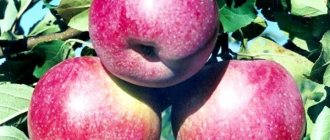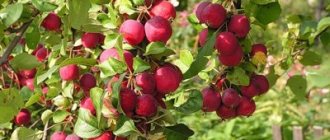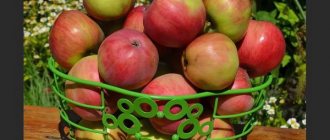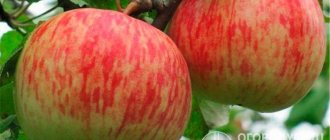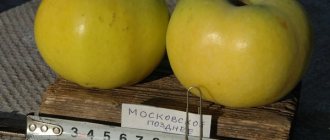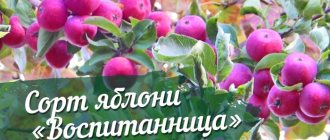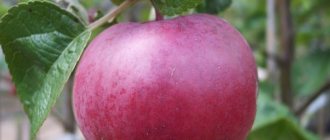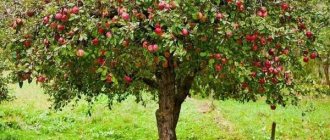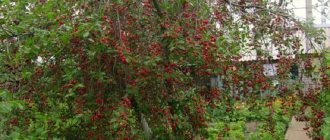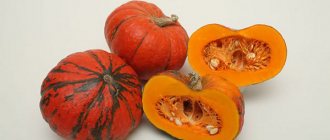For decades, Chinawort and its varieties have been winning fans thanks to their many advantages - high productivity, low maintenance requirements, the ability to withstand both frost and drought, resistance to many diseases and pests, and extraordinary decorative appeal.
In Russia, Chinawort is successfully grown in different climatic zones, including the Urals and Siberia, without requiring special growing conditions. In the article we will talk about this fruit crop, give a description of the varieties of the variety - such as Kerr, Zolotaya and others, and show photos.
general description
Apple trees of the Kitayka variety are usually medium-sized, with a wide crown, strewn with unusually beautiful and fragrant flowers in spring.
Due to this, Chinawort is often planted for decorative purposes . The leaves of the tree are soft green, oblong, with teeth along the edges. The fruits grow small, up to 6 in one rosette, and taste sweet. The variety is distinguished by high yields, but at the same time there are no special requirements for cultivation.
If you are choosing an apple tree variety for your garden, you will find the following review article helpful.
How to plant a Chinese apple tree in spring?
Two-year or three-year-old seedlings take root better. The tree of paradise is not demanding on the composition of the soil, but it is not advisable to grow it on heavy, acidic and swampy soils. Late or early Chinese apple trees are planted similarly to large-fruited varieties:
- Depending on the volume of the root system, a planting hole is dug up to 80x80x100 cm in size.
- When planting in groups, the distance between Raika seedlings is left up to 6 m.
- The nutrient substrate is made from a mixture of humus, river sand and deciduous soil (3:2:1).
- Add mineral fertilizer to the soil - 250 g of ash, 100 g of potassium fertilizers, 250 g of superphosphate.
- The filled hole is watered and the soil is slightly compacted.
- Planting dates: early October or late September.
- The Chinese apple tree grows best in bright areas or in light partial shade.
History of selection
This variety was obtained by crossing the Domestic and Berry apple trees, and was brought by a gardener to the UK from New Zealand. Over time, the variety became widely known, began to spread in European countries and reached Russia. It got its name due to the similarity of the leaves to the leaves of the Chinese plum. That is why Chinaka is also called “plum leaf apple tree.”
Features of the variety
The Chinese plant is distinguished by its unpretentiousness in care and stability of the harvest (and the harvest is annual, there are practically no rest periods). Tolerates frost and drought well. It has stable immunity to many diseases and pests.
You can find information about other varieties of apple trees, as well as how to choose them correctly, here.
Tree height
The trees grow highly branched, mostly of medium height, but some varieties of the variety reach a height of 10 m (Bellefleur, Pink).
Crown width
The crown is medium dense, spreading, with a diameter of up to 5 meters. In some varieties (Bellefleur, Long) the crown grows wide and dense, requiring formation.
Productivity
It is a high-yielding variety - up to 80 kg of apples can be harvested from one mature healthy tree .
Tasting assessment
Most varieties of Chinese have excellent taste and aroma (Kerr, Red, Long, Bellefleur, Golden Early, Cream, Honey).
The harvest is suitable both for fresh consumption and for making compotes, preserves, jams, and dried fruits.
Winter hardiness
Chinese and its varieties are distinguished by high frost resistance , due to which they are successfully grown in the middle zone, in the North-Western region, the Urals and Siberia.
Self-fertility
Chinese is a self-fertile variety. But pollinators will not be superfluous - Belyi naliv and Grushovka Moskovskaya are best suited.
Pollination
Thanks to its bright colors and sweet aroma, Chinawort perfectly attracts insects, which at the same time pollinate plants in the neighborhood.
Description of apples
The fruits grow weighing up to 40 g and have the shape of a ball or oval . The fruits come in different colors depending on the variety - from yellow to red. The pulp is often white and has a sweet and sour taste.
Beginning of maturation
It begins to bear fruit 3 years after planting, although some of its varieties bear fruit only in the 6-7th year (Bellefleur, Saninskaya, Kremovaya).
Want to know how to quickly dry apples in the oven? Then follow the link and read the following material.
Price
The price of seedlings varies depending on the variety . In Moscow and the Moscow region, the average price for a 2-3 year old Golden Kitayka seedling will be 800 - 1,000 rubles.
The Long variety will cost much more when buying a seedling in a store or on the market:
- two-year plan for 900 rubles;
- three-year-old - for 2,000 rubles.
If you want to learn about other popular varieties of apples, for example “Melba”, “Antonovka”, “Anise” or “Borovinka”, read the materials at the links.
Description and characteristics of the Chinese variety
Botanists call this apple tree “Chinese plum leaf.” Varieties of varieties also have different colors of flowers, which are white, pink and even, not typical for apple trees, red . The height of the trees varies from 1 to 9 m. But the leaves of all Chinese trees are the same, have an elongated, pointed shape and a green color, which in the fall transforms into purple or ocher colors. This ability, along with lush flowering and a plentiful harvest of bright-looking fruits, also gives Chinaka its decorative value.
The Chinese apple tree, regardless of the variety, with good care, allows you to decorate the garden and gives a good harvest of fruits
The root system of trees is shallow but strong. The spherical fruits are mostly small, although some varieties are medium-sized and large. The trees are distinguished by their undemanding nature in terms of soil composition, as well as their resistance to drought, cold, diseases and pests. Fruits of small-fruited varieties do not have good shelf life, but varieties with larger fruits can be stored for a long time and tolerate transportation well.
Did you know? By sowing seeds obtained from the fruits of the same apple tree, you can get trees with different properties.
Variety varieties
The advantages of the Chinese woman prompted breeders to develop varieties that would differ in their external and taste qualities. This is how the varieties Kitayka Belfleur, Zheltaya, Long, Kerr and others appeared:
| Varieties | Description | Advantages | Flaws |
| Golden | The result of crossing White filling and Chinese. The tree grows medium-sized in the shape of a pyramid, with slightly drooping branches. The fruits weigh 40-60 g and have a bright yellow color. |
|
|
| Kerr | Obtained by crossing two varieties of Kitayok - Dolgo and Kharalson. The tree is small in size, with a round and compact crown. The fruits grow weighing 35-45 g. |
| Late harvest (apples ripen by mid-September). |
| Bellefleur | A hybrid of Bellefleur yellow and Chinese large-fruited varieties. The tree grows tall, with a dense crown. The fruits grow weighing from 120 to 300 g. |
|
|
| Red | The tree grows small in height, the crown is columnar in shape |
|
|
| For a long time | The trees are low-growing (no higher than 4 m), the branches grow to the sides, which can make the tree look like a bush. The crown is thick and requires shaping. The fruits grow very small - 15-20 g. |
|
|
| Yellow | Obtained by crossing the Bellefleur yellow variety with Kitayka. The fruits grow weighing up to 40 g. |
|
|
| Pink | Tall trees (up to 10 m) with a ball-shaped crown. The fruits grow small, weighing up to 40 g. |
|
|
| Saninskaya | Tall trees with a dense crown. Sweet and sour fruits grow weighing up to 35 g. |
|
|
| Cream | Bred from seedlings of the varietal Chinese Apricot. The tree grows tall (up to 9 m), with a pyramid-shaped crown. The fruits grow weighing 60-80 g. |
|
|
| Honey | The trees grow tall, the crown is round in shape. The fruits are small, weighing up to 40 g. |
|
|
We invite you to watch a video about the variety of Kitayka - the Kerr variety:
Preparing for landing
Strong two-year-old seedlings are selected and preparations for autumn planting begin a month before the onset of frost. The area is cleared of weeds, dug up, leveled, and holes measuring 80*80*80 are dug at a distance of 4-6 m from each other.
At the bottom of each pit, lay a layer of organic matter - slurry or compost. The pits are left to settle for 2 weeks. 2-3 days before planting, mineral additives are added - potassium sulfide, superphosphate and wood ash. On the eve of planting, the roots of the seedlings are moistened in a clay mash.
Photo
Next you can see what Chinese apple trees look like:
You might be interested in learning about another, very aromatic variety - Striped Cinnamon.
Reviews
Marina, doctor : “We grow Red Chinese, which we love for its unpretentiousness, easy care, and the fact that it does not require pruning. Apples are stored for 2 months. We love to eat it right away and make jam – it turns out very beautiful.”
Elena, accountant : “We have two varieties growing at our dacha - Bellefleur and Zolotaya. Both bloom very beautifully and produce a good harvest. It’s convenient that Zolotaya ripens early – we use its apples to make marshmallows. We store bellefleur until winter, and we also prepare jams and compotes.”
Oksana, auditor : “On the advice of friends, we imprisoned China Kerr, and did not regret it. Firstly, it blooms very beautifully, and it looks very beautiful in the summer. Apples last a long time, so we eat them all fall. I also liked making compotes from it.”
Nikolai, pensioner : “We planted the Golden Chinese plant a long time ago - now every year the apple harvest begins with it. The apples are tasty, the harvests are generally large, but they do not last long. So what we don’t have time to eat right away goes into storage.”
Olga, teacher : “Instead of the old Golden Chinese, they planted the Red one - it is even easier to care for, since it does not need to be pruned. Apples last longer, so we have time to eat enough and prepare compotes for the winter. Both bloomed very beautifully – you can plant them even just for that.”
Collection, transportation and storage periods
After ripening, the apples begin to crumble quite quickly, so harvesting should not be delayed.
When stored in the refrigerator, some varieties (Kerr, Bellefleur) can last until winter (provided there is no mechanical damage). But in general, the fruits are not stored for long - no more than three weeks. They tolerate transportation well, but in case of injury they will quickly deteriorate.
Another good summer variety is the Candy apple tree. Follow the link to find detailed information about this variety.
Chinese apple tree - how to propagate?
The main ways to obtain high-quality seedlings of the fruit Raika are grafting or sowing seeds. In the second case, parental properties are not always preserved, and fruiting will have to wait longer (up to 5-12 years). Apple tree seeds are sown using the following technology:
- Remove the seeds from the fruit.
- Rinse and dry the material.
- Soak the seeds in warm water with the addition of a stimulant (Epin or analogues).
- Place the seeds in a substrate of damp sawdust and sand.
- Place the container in the refrigerator or basement for 60-90 days.
- When sprouts appear, transplant the seedlings into boxes with soil or into a container.
- Planting depth is up to 2 cm, intervals between seedlings are 20 cm.
It is easier to graft a good variety of Chinese apple tree onto a suitable seedling. Plum-leaved trees are not compatible with all types of rootstocks. On Antonovka and Papirovka, the rayka scion does not take root well. It grows well with Melba and Pepin saffron. Practice shows that the best option for grafting is another seedling of a small-fruited apple tree growing in the area. In the absence of such material, it is better to use varieties whose parents include Chinese.
Features of cultivation
In the first 4-5 years after planting, it is recommended to remove up to 80% of the fruits - this will allow the apple tree to strengthen and produce abundant harvests in the future.
In addition, for Kitayka it is extremely important to carry out formative pruning so that the crown develops evenly. The branches must be trimmed to approximately the same length - this will allow the tree’s strength to be directed towards fruit growth. Preventive treatment against diseases and pests is required already in the first year of a tree’s life.
When to plant and how to choose a seedling?
Planting a young apple tree is best done in the fall, at the end of September or beginning of October.
But planting in early spring is also allowed . You should choose seedlings that are 2-3 years old with a well-developed root system, as they take root faster.
Selection and preparation of a site, distance to other trees
Chinese women love well-lit places where there is no possibility of accumulation of melt water or where groundwater flows nearby. The most suitable soil is loam or sandy loam, non-acidic, moderately moist. When planting, maintain a distance of at least 6 m between trees or to outbuildings and fences. The depth of the hole is 70-80 cm, the width is up to 100 cm.
Expert opinion
Klimkina Elena Vladislavovna
Florist, businessman. Organized her business on a country plot of land
It is necessary to add a layer of fertile soil to the bottom of the hole - mix three parts of humus, two parts of river sand, one part of deciduous soil. To this mixture add 250 g of wood ash, 250 g of superphosphate, 100 g of potassium sulfate. Fill the hole one-third with the resulting mixture, place the seedling in it, and then carefully fill the hole, gradually compacting the soil.
It is important to ensure that the root collar is 5-7 cm above ground level. After planting, you need to water the seedling generously with settled water and mulch with humus.
Can it grow in one place for a long time?
If the apple tree is immediately planted in a permanent place, then there is no need for replanting. In addition, trees older than 3 years do not tolerate transplantation well . If there is a need for replanting, this should be done in early spring before sap flow begins.
- The tree is dug up with a large lump of earth (the diameter of the lump should be approximately equal to the diameter of the crown) and carefully placed on a piece of burlap.
- Then they are dragged to a new location and placed in a previously prepared hole.
- The pit is prepared as during the initial planting of a seedling.
- It is recommended to do a little pruning almost immediately - this will allow the tree to recover faster.
How to prune in the fall and form a crown?
Such varieties of Chinese as:
- Bellefleur;
- Golden;
- For a long time;
- Saninskaya;
- Pink.
In these varieties, the crowns themselves grow wide and spreading, and under the weight of the harvest, the branches can easily break. They begin to form the crown a year after planting, in March, when the temperature does not drop below +10°C. During the first pruning, the branch that competes with the main one is removed. The main branches can also be shortened if they are too long.
Secondary branches should be spaced evenly around the center - this will allow the correct shape of the crown to be formed.
There are two possible pruning methods depending on the variety of Chinese:
On the outer bud - used when you need to expand the crown and make it less dense. In this case, the upper bud is left, which is directed away from the trunk.
- On the inner bud - used when you need to strengthen the center of the tree. To do this, leave the upper bud directed towards the trunk.
Subsequently, the mature tree is annually pruned to maintain the shape of the crown and prevent its excessive thickening. After pruning, it is necessary to lubricate the cut areas with garden varnish or oil paint.
Feeding
The first two years the apple tree does not need feeding . Then fertilizing is carried out annually - for this in the spring, 3 weeks before flowering, mineral (urea or ammonium nitrate) and organic fertilizers are applied.
Then, at the stage of ovary formation, a second feeding is carried out - it is best to take 250 g of nitrophoska and dilute it in a bucket of water. After harvesting, fertilizers are applied a third time - you can take 250 g of superphosphate and 150 g of potassium sulfate per bucket of water.
Graft
Chinawort is often used for grafting - summer and autumn varieties, for example, Melba, Pepin Saffron, are well suited. Antonovka, on the contrary, is poorly compatible with China. The rules for grafting are standard as for most varieties .
Permissible groundwater level
Apple trees do not like excessively wet areas or those places where groundwater flows close (less than 2 m), as these factors negatively affect the quality of the crop.
Protection from cold and rodents
Despite the fact that the variety tolerates frost well, the trees need to be prepared for winter. The roots should be covered with a layer of mulch - peat, humus, and rotted sawdust are suitable for this. In spring, the mulch is removed. The trunks can be covered with spruce branches or wrapped with old newspapers - this will protect the trees from rodents.
Growing an apple tree
Subsequent care for Chinese seedlings consists of:
- glaze;
- feeding;
- trimmings;
- prevention and control of diseases and pests;
- preparation for winter.
It is interesting to read about the cultivation of such summer apple varieties as Medunitsa and Mantet.
Fertilization and watering
Chinese varieties are afraid of stagnation of water in the roots and are tolerant of drought. These trees should not be watered frequently, limiting yourself to 4 buckets of settled warm water once every 10 days . Each watering, as well as the previous rain, must be accompanied by loosening the tree trunk circle to ensure good access of oxygen to the root system. Before the onset of frost, the tree trunks of apple trees are mulched with a thick layer of humus.
The frequency of loosening can be reduced by mulching the soil, using:
- dry sawdust;
- crushed peat;
- hay;
- dry humus;
- crushed bark.
When the seedlings, 2 years after planting, have used up the fertilizers applied during planting, in the spring they should be fed 3 weeks before flowering with nitrogen-containing fertilizers, organic matter, and ammonium nitrate.
Diseases and pests
Chinese and most of its varieties have good immunity against diseases , however, spring prophylaxis with “Hom” preparations and a solution of copper sulfate against cytosporosis will not be superfluous. The variety is well resistant to scab, but if the tree still gets sick, the following remedies are used:
- copper sulfate;
- “Horus”;
- “Skor”;
- “Home”;
- “Nitrophen”;
- urea.
Among the pests, Chinawort can be overcome by aphids; to combat them, a soap solution with tobacco is most often used. Apple moths and apple blossom beetles are afraid of chlorophos.
The nuances of growing in different regions
- In the Moscow region, planting conditions and care rules are standard.
- In the Southern regions, it is important to follow the watering rules - you need infrequent but abundant watering - 3-4 buckets per tree. After watering, the ground around the tree should be mulched.
- In the Middle Zone, care conditions are no different. The only point is that young plants should be planted no earlier than the first half of April.
- In Siberia, it is recommended to take 3-year-old seedlings for planting, which are immediately treated with growth stimulants.
Since in the northern regions the soils are predominantly heavier, therefore the planting hole is dug deeper and wider. For the winter, trees must be insulated with covering material and the soil mulched. It would also be useful to additionally fertilize with potassium and phosphorus in the fall. The varieties Long, Kerr, and Pink are best suited for growing.
The variety of Chinese varieties, as well as their overall adaptability to growing in almost any weather conditions, make this variety extremely attractive. The sweet taste and aroma of the fruit are suitable both for those who like to eat fresh apples and for those who prefer to prepare preserves, jams and compotes.
Chinese apple tree in landscape design
In terms of beauty in a garden plot, a well-groomed Raika is not inferior to many exotic crops. In cold regions, the elegant ornamental Chinese apple tree will successfully replace flowering tall shrubs in May-June. By the end of summer and autumn, productive plants bring the pleasure of contemplating a lush crown strewn with small reddish or golden fruits. Examples of using Chinese in landscape design:
- Blooming paradise apple tree in a flowerbed.
- Fruit-bearing Raika near the house.
- Yellow-fruited Chinese on the lawn.
- Decorative apple trees among flowers.
